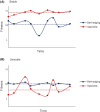Ecological, (epi)genetic and physiological aspects of bet-hedging in angiosperms
- PMID: 33449209
- PMCID: PMC7902588
- DOI: 10.1007/s00497-020-00402-z
Ecological, (epi)genetic and physiological aspects of bet-hedging in angiosperms
Abstract
Bet-hedging is a complex evolutionary strategy involving morphological, eco-physiological, (epi)genetic and population dynamics aspects. We review these aspects in flowering plants and propose further research needed for this topic. Bet-hedging is an evolutionary strategy that reduces the temporal variance in fitness at the expense of a lowered arithmetic mean fitness. It has evolved in organisms subjected to variable cues from the external environment, be they abiotic or biotic stresses such as irregular rainfall or predation. In flowering plants, bet-hedging is exhibited by hundreds of species and is mainly exerted by reproductive organs, in particular seeds but also embryos and fruits. The main example of bet-hedging in angiosperms is diaspore heteromorphism in which the same individual produces different seed/fruit morphs in terms of morphology, dormancy, eco-physiology and/or tolerance to biotic and abiotic stresses in order to 'hedge its bets' in unpredictable environments. The objective of this review is to provide a comprehensive overview of the ecological, genetic, epigenetic and physiological aspects involved in shaping bet-hedging strategies, and how these can affect population dynamics. We identify several open research questions about bet-hedging strategies in plants: 1) understanding ecological trade-offs among different traits; 2) producing more comprehensive phylogenetic analyses to understand the diffusion and evolutionary implications of this strategy; 3) clarifying epigenetic mechanisms related to bet-hedging and plant responses to environmental cues; and 4) applying multi-omics approaches to study bet-hedging at different levels of detail. Clarifying those aspects of bet-hedging will deepen our understanding of this fascinating evolutionary strategy.
Keywords: Bet-hedging; Eco-physiology; Fitness; Heteromorphism; Seed dormancy; Soil seed bank.
Conflict of interest statement
The authors have no conflicts of interest to declare that are relevant to the content of this article.
Figures




Similar articles
-
Evolutionary bet-hedging in the real world: empirical evidence and challenges revealed by plants.Proc Biol Sci. 2010 Oct 22;277(1697):3055-64. doi: 10.1098/rspb.2010.0707. Epub 2010 Jun 23. Proc Biol Sci. 2010. PMID: 20573624 Free PMC article. Review.
-
Dynamics of the diaspore and germination stages of the life history of an annual diaspore-trimorphic species in a temperate salt desert.Planta. 2020 Mar 28;251(4):87. doi: 10.1007/s00425-020-03380-8. Planta. 2020. PMID: 32222827
-
Offspring polymorphism and bet hedging: a large-scale, phylogenetic analysis.Ecol Lett. 2020 Aug;23(8):1223-1231. doi: 10.1111/ele.13522. Epub 2020 May 13. Ecol Lett. 2020. PMID: 32406146
-
Developmental Control and Plasticity of Fruit and Seed Dimorphism in Aethionema arabicum.Plant Physiol. 2016 Nov;172(3):1691-1707. doi: 10.1104/pp.16.00838. Epub 2016 Oct 4. Plant Physiol. 2016. PMID: 27702842 Free PMC article.
-
Bet-hedging--a triple trade-off between means, variances and correlations.Biol Rev Camb Philos Soc. 2012 Aug;87(3):742-55. doi: 10.1111/j.1469-185X.2012.00225.x. Epub 2012 Mar 10. Biol Rev Camb Philos Soc. 2012. PMID: 22404978 Review.
Cited by
-
Empirical Evidence of a Bet-Hedging Strategy in the Carrot Cyst Nematode Heterodera carotae.Ecol Evol. 2025 Aug 6;15(8):e71918. doi: 10.1002/ece3.71918. eCollection 2025 Aug. Ecol Evol. 2025. PMID: 40771547 Free PMC article.
-
Phenotypic plasticity as the main driver of alien plant trait variation in urban versus rural microclimate for the model species Veronica persica.Oecologia. 2024 Aug;205(3-4):643-654. doi: 10.1007/s00442-024-05597-w. Epub 2024 Jul 29. Oecologia. 2024. PMID: 39073568
-
A Travel through Landscapes of Seed Dormancy.Plants (Basel). 2023 Nov 24;12(23):3963. doi: 10.3390/plants12233963. Plants (Basel). 2023. PMID: 38068600 Free PMC article. Review.
-
Aethionema arabicum dimorphic seed trait resetting during transition to seedlings.Front Plant Sci. 2024 Mar 8;15:1358312. doi: 10.3389/fpls.2024.1358312. eCollection 2024. Front Plant Sci. 2024. PMID: 38525145 Free PMC article.
-
Factors Influencing the Emergence of Heterogeneous Populations of Common Bean (Phaseolus vulgaris L.) and Their Potential for Intercropping.Plants (Basel). 2024 Apr 16;13(8):1112. doi: 10.3390/plants13081112. Plants (Basel). 2024. PMID: 38674521 Free PMC article. Review.
References
Publication types
MeSH terms
LinkOut - more resources
Full Text Sources
Other Literature Sources

